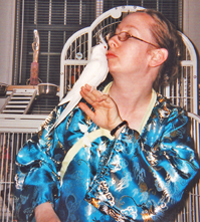Aviculture: Difference between revisions
| Line 6: | Line 6: | ||
This was in stark contrast with the [[parrots]], highly social birds kept in captivity but never domesticated. Even after scores of generations in captivity, most companion parrots are little different from their wild cousins. The main difference, in fact, is that certain species of companion parrots, of which budgies and cockatiels are most popular, have color mutations in captivity that do not, usually cannot, persist in the wild. Wild cockatiels, for example, are always grey birds in their native Australia. However aviculture has developed literally dozens of color mutations that, while beautiful to our eyes, would quickly make the bird visible to predators. |
This was in stark contrast with the [[parrots]], highly social birds kept in captivity but never domesticated. Even after scores of generations in captivity, most companion parrots are little different from their wild cousins. The main difference, in fact, is that certain species of companion parrots, of which budgies and cockatiels are most popular, have color mutations in captivity that do not, usually cannot, persist in the wild. Wild cockatiels, for example, are always grey birds in their native Australia. However aviculture has developed literally dozens of color mutations that, while beautiful to our eyes, would quickly make the bird visible to predators. |
||
[[Image:Aisin Biya Mithril 3b 8-10-06.jpg]] |
|||
Aisin Biya's cockatiel, Mithril, is a rare whiteface lutino (aka albino) mutation. The genetics involved in producing an albino (almost exclusively hens) cockatiel mean that birds like Mithril can only exist in aviculture. |
|||
Revision as of 07:02, 5 January 2007
Aviculture
Aviculture is the art of keeping and/or breeding birds for companionship. Unlike falconry, aviculture is an art historically and currently accessible to anyone, though the species available might vary with geography, social status, and the economic circumstances of the aviculturists. The keeping of parrots, for example, is one of the more expensive and time consuming forms of aviculture with a constant shift in species available to individuals. Parrot aviculture is also the form that has changed the most over time as technology and social attitudes have changed. For better or for worse, parrots have often experienced every shift in the human condition over the centuries.
But aviculture is not limited to parrots, though today it is the form we most associate with the art. By the medieval period, several species of birds had been domesticated (just as canines were). These domestic birds are typically members of either the finch branch (which includes canaries and sparrows) or the dove branch. The species of finches and doves kept was generally determined by geography as there was little demand for imports from far flung corners of the world.
This was in stark contrast with the parrots, highly social birds kept in captivity but never domesticated. Even after scores of generations in captivity, most companion parrots are little different from their wild cousins. The main difference, in fact, is that certain species of companion parrots, of which budgies and cockatiels are most popular, have color mutations in captivity that do not, usually cannot, persist in the wild. Wild cockatiels, for example, are always grey birds in their native Australia. However aviculture has developed literally dozens of color mutations that, while beautiful to our eyes, would quickly make the bird visible to predators.
Aisin Biya's cockatiel, Mithril, is a rare whiteface lutino (aka albino) mutation. The genetics involved in producing an albino (almost exclusively hens) cockatiel mean that birds like Mithril can only exist in aviculture.
History of Parrot Aviculture in Period
The history of parrot aviculture in Europe officially begins with Alexandre the Great's expeditions to India in which he encountered and brought back three species of psiticula parakeet: the Indian ringneck, the plum headed, and of course the Alexandrine parakeet. Based on the records of Alexandre's journeys, it is clear that in Asia, the art of aviculture had extended to parrots some time before--natural as there are many species native to India. Specifically, the Indians had/have a cultural tabboo against eating parrots, seeing them as a class of bird worthy of special protection. Like all psiticula parakeets, the birds brought back to Europe for aviculture were/are predominently green in color with a long tail. The three aforementioned species have a collar of contrasting color around the base of the head. In Roman times, the black collar of the Alexandrine parakeet suggested subservience to humans, ordained by the gods (later the Christian god as well). This proved to be the beginning of many inhumane attitudes towards parrots that were accepted without question by medieval europeans.
Aviculture in the SCA
The art of aviculture in the SCA is suprisingly new, despite the fact that from the beginning, many SCAdians have kept birds as companions.
In fact it was not until August, 2006 when Aisin Biya of the Canton of Brokenbridge in Ostgardr East Kingdom started the Company of Medieval Aviculturists that the ancient and highly popular art finally reached the SCA. This effort sprang from Biya's increasing awareness that most SCAdians, as well as the general public, know precious little about aviculture.
Encouraged by falconry laurel, Mistress Brianna, Biya began researching medieval aviculture in July, 2006. On August 14th, following a demo at which both bird gentles assisted, Aisin Biya founded the Company of Medieval Aviculturists as a way of promoting the art of aviculture and the arts and sciences contained within that art.
